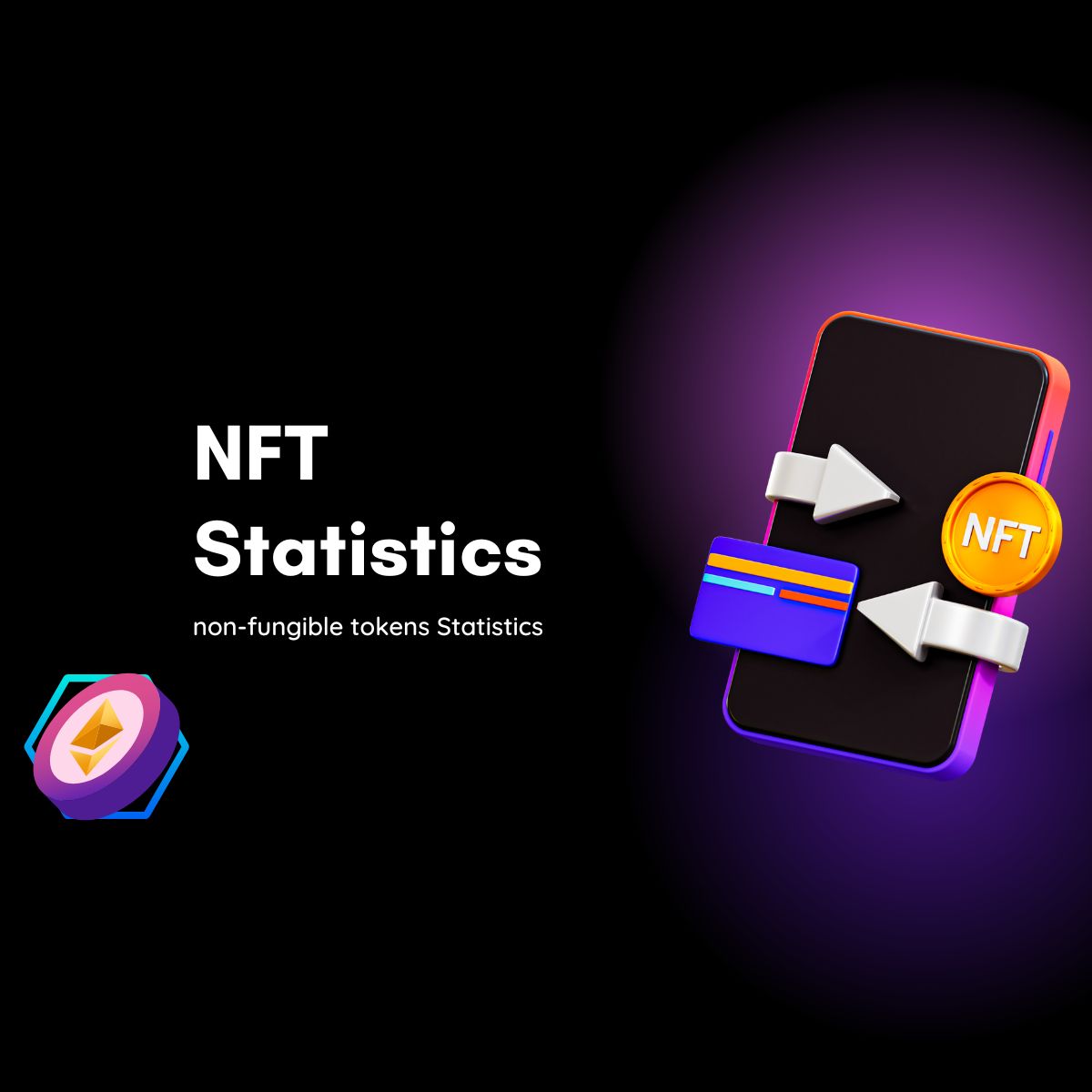20+ Amazing Gamification Statistics, Trends, Facts For 2023
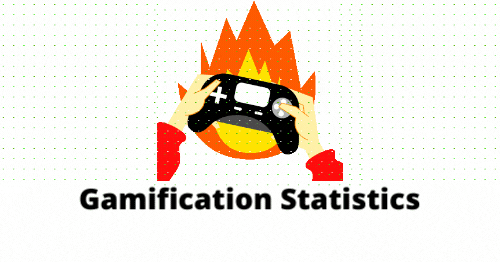
Page Contents
- What is Gamification?
- Fascinating Gamification Statistics (Editor's Choice)
- Gamification Market Value by Years
- Gamification Industry Statistics
- Gamification Statistics by Social Media Impact
- Gamification Statistics By Employees
- Gamification Statistics By Company: Results
- Gamification Statistics By Top Benefits
- Gamification Statistics By Student Usage
- Gamification Statistics by Preferred Adult Learners
- Conclusion
Gamification Statistics: Gaming is an enjoyable part of almost every aspect of our lives. Even apps that don't operate in the mobile game industry can reap the benefits of Gamification. You can turn your application into an interactive game, harness the power of competition, and encourage people to “beat” it.
Suppose you don't know how to improve retention with Gamification or what its specific benefits are. In that case, this Gamification Statistics will discuss several ways it has been beneficial to applications and all other types of retention.
What is Gamification?
Gamification is the process of incorporating game features into non-game applications, experiences, or products. It has a lengthy history, with games and game-like experiences incorporated into a wide range of activities for millennia. It frequently assists people in engaging with activities they might otherwise avoid, such as schooling and work.
Gamification allows people to set goals and enjoy the process. In addition, Gamification has numerous possible features that might turn an otherwise mundane experience into a game. These elements include badges, points, timers, and leaderboards. These components can be integrated into your app experience to make it more engaging.
Furthermore, Gamification has swept the country and the globe in recent years. More and more successful companies are adding gaming components to employee training and work experiences to boost productivity and engagement at the workplace.
You may wonder, “Is gamification beneficial for all applications?” The short answer is yes. Gamification can be used in various ways by any application. Here are some statistics to prove this.
Fascinating Gamification Statistics (Editor's Choice)
- Companies that use Gamification at work—whether with employees or customers—are seven times more profitable than those that do not.
- 72% of respondents believe that Gamification stimulates them to work harder and do more of the assigned tasks.
- Employee engagement rises by 60% on average when they work in a gamified environment.
- The gamification market in North America is worth $2.72 billion, with the United States leading the way.
- 90% of employees believe that Gamification helps them be more productive at their jobs.
- Between now and 2025, the global market for game-based products and services is expected to grow at 12.9% CAGR.
- 67% of pupils agree that gamified education is more motivating and engaging than traditional classes.
- Gamification has been shown to improve student productivity by 50%.
- Student productivity has been shown to increase by 50% due to gamification.
- $25.7 billion is the expected market size for gamified learning by 2025.
- 90% of employees are more likely to be productive when they use gamification.
- When the tasks are gamified, Gamification Statistics say that employees are 69% more likely to stay with the same company for more than 3 years.
- 95% of the employees are in support of gamified systems.
- The overall Gamification Industry will become more dominant with the use of VR, MR, and AR.
Gamification Market Value by Years
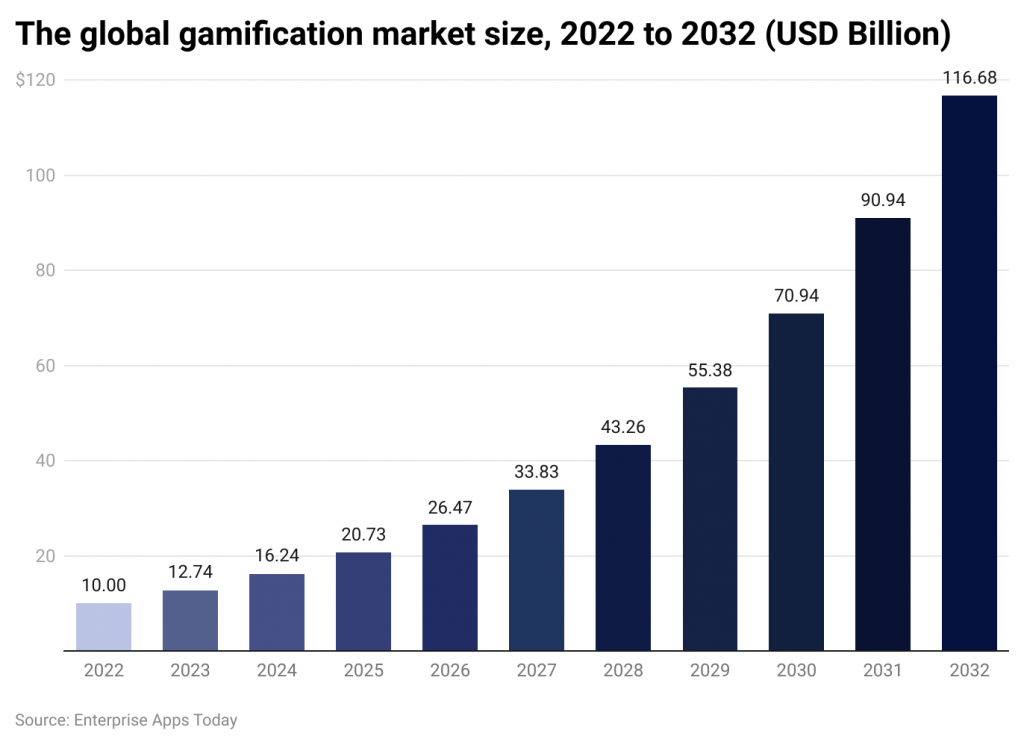 (Source: precedenceresearch.com)
(Source: precedenceresearch.com)
In the coming years, the Gamification market is expected to reach $116.68 billion growing at a CAGR of 27.9% by 2032
Gamification Industry Statistics
#1. 70% worldwide around 2000 businesses use Gamification.
Many companies across the globe are incorporating gamification elements into their workplaces as game-based learning promotes employee productivity, profitability, and engagement. Experts estimate that up to 70% of Global 2000 companies, which are the largest 2,000 companies in the world, use Gamification.
Companies with engaged workers are 21% more efficient, 22% more profitable, and 10% better at satisfying customers. As a result, Gamification is an option for many businesses that can lead to success.
#2. The global gamification market is worth $11.94 billion at the moment.
Global gamification was valued at $11.94 Billion in 2021. This is an increase of $7.03 billion over 2016 Comparatively, the North American market for gamification was valued at $2.72 billion in 2019, with the US leading the charge.
These numbers are projected to rise significantly over the next few years. Experts predict that the global market value will increase by almost $20 billion, with North America being the largest market.
Gamification Statistics by Social Media Impact
- Websites that have incorporated gamification options, experience a 29% increase in site actions.
- Gamification can increase social media sharing by 22%.
- Moreover, it can also increase commenting by 13%.
- Content discovery is 68% more likely to increase by incorporating activity feeds on social media or websites.
Gamification Statistics By Employees
#3. Employee happiness rises by 89% in a gamified workplace.
A whopping 89% of the surveyed workers stated that Gamification makes them more happy and more productive at their workplace. In comparison, 53% of American workers are dissatisfied with their jobs. As a result, Gamification has the potential to have significant positive effects.
Additionally, A gamified workspace can help with employee retention as well as increase employee productivity and happiness since 69% of workers said they would stay with a company for longer than three years if there were Gamification at work.
#4. Around 30% of employees say that games-based learning makes them more engaged.
Gamification can increase the productivity of 90% of employees, but it also improves the on-the-work engagement level. For example, according to a survey of 500 business employees, 30% of respondents believe that Gamification increases their desire to be engaged in the workplace.
Furthermore, according to the same survey, Gamification motivates 27% of employees to be more productive on the job and aids up to 20% of people in staying focused and avoiding distractions at the workplace.

#5. A staggering 95% of employees want a gamified work environment.
Nearly all workers surveyed stated that they enjoyed aspects of Gamification at their jobs.
Many job seekers see Gamification as a key element in their search for work. According to one report, 78% of those polled believe that Gamification in recruiting would make a firm or position more appealing.
#6. Outside of work, approximately half of American employees are casual gamers.
Casual gamers account for an anticipated 80 million white-collar professionals in the United States. In addition, according to a recent survey, around 24% of all white-collar office workers in the United States play casual video games at their work, with up to 35% of (CEO) chief executive officers, (CFO) chief financial officers, and other top-level executives playing casual games at their work.
According to the survey, 65% of the workers admitted to casual gaming at the workplace at least once a month. Nearly 61% claimed that they play different games during their break time and lunch hour, while 52% of respondents said that they play games during their regular workday
#7. 61% of employees in the United States receive training with Gamification at the workplace.
Many employees in the United States receive on-the-job training that includes gaming elements. Recent data shows that 83% of employees who have gamified training feel motivated, while 61% of those who get regular training with no gamification feel bored.
Gamification Statistics By Company: Results
#8. Employee performance and customer satisfaction improve when Gamification is utilized to motivate employees.
For example, LiveOps, a customer service business, used Gamification to build an employee application and implement a rewards program in order to address low morale and high turnover.
After the program launched, participants showed superior performance to their colleagues, their average call-handle time improved by around 23%, and increasing customer satisfaction by 9%.
#9. Regarding workplace gamification, poor preparation has resulted in substantial failure.
Due to inadequate design and planning, as well as a lack of creativity and meaning, a projected 80% of workplace gamification efforts fail to achieve a company's objectives.
#10. Gamification has 14% high scores in skill-based tests.
Adult learners benefit substantially from gamified environments. According to a University of Colorado study, Gamification results in 14% higher scores on a skill-based knowledge test and 11% higher scores on factual knowledge assessments.
Gamification Statistics By Top Benefits
#11. Gamification aids in significant improvement in information retention.
According to Gabe Zichermann (Canadian-American author, businessman, and public speaker), incorporating Gamification into daily work and training helps make dull tasks enjoyable, boosting employee skill retention by around 40%.
#12. The impact of Gamification on user engagement is overwhelmingly favorable.
According to recent studies, Gamification increases employee engagement by nearly 60%.
Furthermore, according to a survey of 500 corporate workers, 30% of respondents believe that Gamification increases their desire to be engaged at work. As a result, Gamification increases both engagement and the willingness to participate in any given task.
#13. The enhanced productivity, profitability, and employee engagement linked to a gamified environment are the main causes of Gamification's recent explosion in popularity.
Experts claim that Gamification is popular among business owners, teachers, and managers because it enhances memory retention, integrates real-world problem-solving into learning environments, offers genuine opportunities to hone skills with little to no risk, and enables automatic and instant feedback.
Gamification Statistics By Student Usage
#14. Gamified learning experiences are preferred by nearly 67% of pupils in the United States.
Compared to traditional educational approaches, approximately 70% of students prefer gamified classrooms and learning experiences. They point out increased motivation, engagement, and other benefits as the main reasons that drew them to gamified learning.
#15. In some cases, Gamification has been shown to increase student test results by up to 34%.
In one case study, a math teacher in an elementary school discovered that after incorporating math games into his students' learning curricula for four months, the average test scores rose from 49% to 83% – a 34% increase.
It is projected that approximately 75% of all K–-8 instructors in the US use digital games for instruction to some level due to the incredible success rate that Gamification has on student's test results and learning.
#16. Student productivity has been shown to increase by 50% due to Gamification.
It should be no surprise that nearly 50% of US workers believe that Gamification increases productivity. Around 80% of American workers say that gamified learning experiences are more interesting than traditional training exercises.
Trends And Predictions In The Gamification Industry
#17. Gamified learning is expected to reach $25.7 billion in 2025.
Gamification in education will grow at a 14% annual rate between now and 2025. This rate would mean that the market would be worth $25.7 billion in 2025, which is $12.3 billion more than the current market value.
#18. The global gamification market has increased by $7.03 billion in the last five years.
Over the last few years, Gamification has exploded in popularity. The global gamification market was valued at $4.91 billion in 2016. Meanwhile, the latest figures show an approximately 143% rise because The market's value is now $11.94 billion.
#19. The global gamification industry will grow at a rate of 27.4% over the next few years.
Experts predict that the international gamification market will grow at a compound annual rate (CAGR of 27.4%) between 2020-2025. It is expected to rise from $9.1 million in 2020 to $30.7 billion by 2025.
The gamification market is expected to see a greater ROI (return on investment) due to the substantial growth in employee engagement and performance.
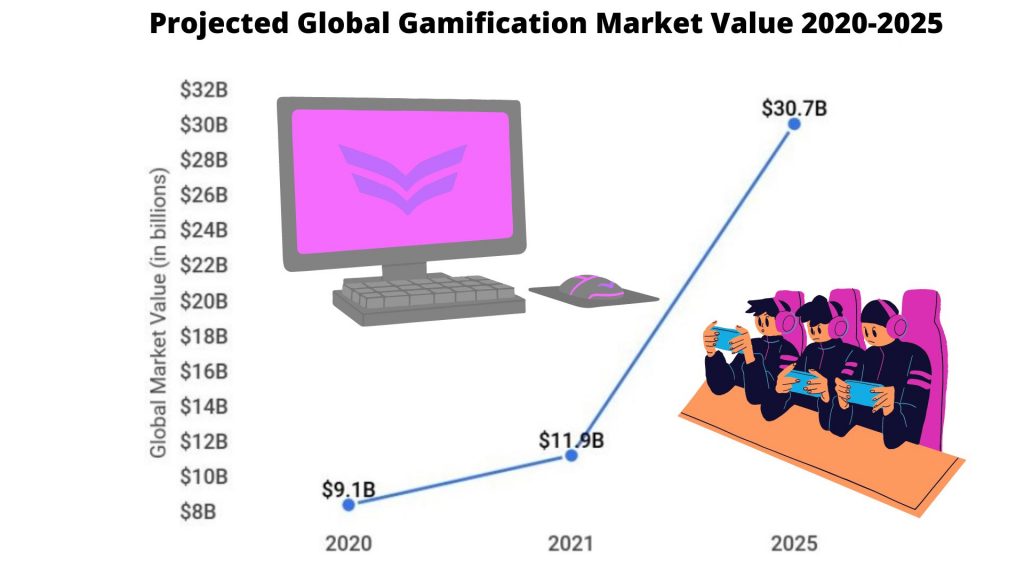
Gamification Statistics by Preferred Adult Learners
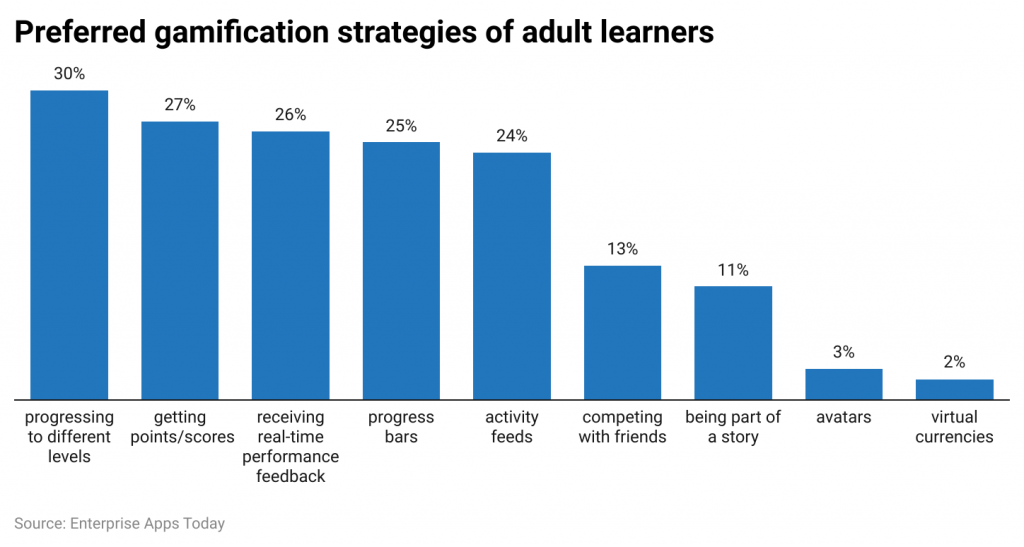 ( Source: financesonline.com)
( Source: financesonline.com)
The top most preferred gamification strategy preferred by adult learners is progressing to different levels resulting in 30%, followed by getting points or scores (27%) and receiving real-time performance feedback (26%). The least desired strategy is virtual currencies at 2%.
Conclusion
Gamification is a growing industry around the globe that has seen massive success over the past few years. According to current evidence, gamified learning and working environments are directly related to high student and staff success rates and profitability. These types of surroundings increase productivity, efficiency, enjoyment, and motivation.
Gamification is still a very lucrative field for businesses all over the country. Around 90% of employees have reported that Gamification can improve their productivity. Gamification can make it possible for companies seven times more productive, and therefore more profitable than those that don’t.
Gamification is a promising industry with a market estimated to grow by around $20 billion worldwide.
FAQ.
The immense success of Gamification can be directly linked to the higher motivation, productivity, as well as engagement that results from employees and students working, interacting, and learning in a game-based environment.
Around 95% percent of employees surveyed stated that they enjoy Gamification in the workplace. These enjoyable features of Gamification are said to improve employee skill retention by up to 40%. Another staggering 30% of workers believe that games-based learning makes them more engaged, leading to higher gamification success.
Gamification is primarily utilized in HR to aid in employee recruitment, onboarding, and training. Some application processes include gamified components such as personality questionnaires that help understand employee referral policies and work-related behaviors, among others.
In addition, Gamification is even more important when onboarding new staff. Several onboarding programs often include many video content on company policies, and quizzes are often included at the end to verify comprehension. This sense of progress, achievement and easy wins is excellent for raising retention rates and instilling confidence in new hires on their first day.
Finally, Gamification is frequently used in employee training beyond the onboarding process. For instance, Walmart employs a computer game to verify that its staff is well-versed in the company's safety regulations.
In the United States and around the world, Gamification is one of the most popular businesses and learning tools. Around the world, Gamification is used in some ways by 70% of the worldwide 2000 businesses.
According to research, around 50% of startups in the United States use Gamification. According to US data, 80% of American families own at least one gaming gadget.
The issue that gamification addresses are that several necessary and helpful tasks and activities are tedious and uninteresting. In addition, Gamification aims to make learners, employees, or students appreciate the task's gamified incentive system, making it appear less unpleasant to complete.
Gamification increases productivity for many people by addressing the issue of poor engagement. The reason is quite simple: when individuals are actively involved in an activity, they complete tasks faster and are less distracted. Gamification, in a way, "solves" two issues: low productivity and poor engagement.
Gamification is a powerful tool for motivating students and employees, as well as boosting engagement and productivity. Additionally, Gamification has been connected to enhanced profitability and efficiency in the workplace, as well as dramatically improved customer and employee experiences and higher staff retention rates.
The gamification industry is worth billions of dollars. The current global gamification market value is $11.94 billion. This is an increase of $7.03 billion from 2016. In comparison, the North American gamification market was valued at $2.72 billion in 2019, headed by the United States.
The gamification sector is predicted to boom over the next few years. Experts predict a nearly $20 billion increase in global market value, with North America leading the way.
Yes, Gamification is the way of the future, according to the figures. The sector continues to expand as more people and organizations recognize the benefits of Gamification and profit from them. Currently, Gamification is used in some ways by 70% of worldwide 2000 businesses and around 75% of K-8 instructors in the US.
The global gamification market is estimated to grow at a CAGR of 14% between now to 2025, while the international game-based services and products industry is anticipated to grow at a CAGR of 12.9% between now - 2025.
Using Gamification for training can have several drawbacks, such as creating an unhelpful incentive system and alienating employees who do not love games.
The most prevalent criticism of gamified assessments after training videos is that they do not honestly examine whether the participant understood the videos but rather their ability to answer straightforward multiple-choice questions. Instead of obtaining actual practical knowledge of their job, the incentive becomes finishing the game, passing the quiz, or getting a high score.
Moreover, some individuals prefer a traditional training regimen that provides clear instructions. For them, Gamification may be an inconvenient and undesired extra step that deters them from completing their training. As a result, it is critical to see Gamification as a piece of the HR puzzle rather than the whole package.

Barry is a lover of everything technology. Figuring out how the software works and creating content to shed more light on the value it offers users is his favorite pastime. When not evaluating apps or programs, he's busy trying out new healthy recipes, doing yoga, meditating, or taking nature walks with his little one.


